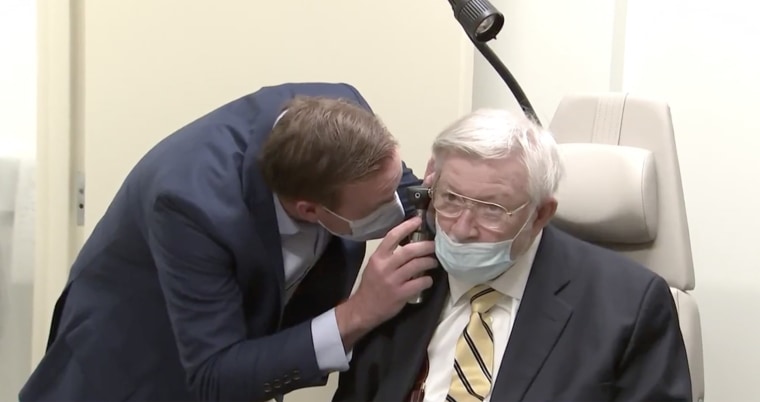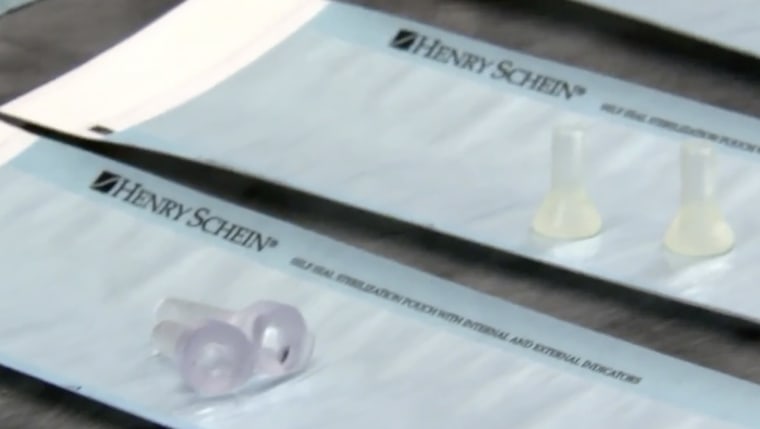After retired Army specialist and former engineer Michael Nicoletti began to lose his hearing, he developed a simple but ingenious solution. Now, that solution has been granted a limited approval by the Food and Drug Administration and might be used to help others with hearing loss.
Nicoletti, 76, said that his hearing loss came on "gradually and insidiously" over the course of years.
"The final cruncher was I was watching TV, and my wife would set the volume for about 20," Nicoletti told TODAY's Craig Melvin. "You know how that works. And I would set the volume for 45, and I said 'You know, I have an ear problem!'"
Nicoletti began to use his engineering skills to try to come up with a solution. He turned to a pantry staple: a simple drinking straw.
"I walked into the kitchen and I saw this — we have a stack of straws," Nicoletti said. "And I said 'You know, what would happen if I cut one of those straws off? And so I did. I cut two pieces off, about an inch long, and I stuck them in my ears."
Nicoletti tested the straws against his TV, and found that he only had to keep the volume at a "setting of 20 or 25" to hear. However, the homemade method wasn't a permanent fix, so he was soon referred to audiologist Dr. Kent Flanagan, who works at the Ralph H. Johnson VA Medical Centers in Charleston, South Carolina.
While Flanagan said he was a little alarmed by Nicoletti's straw solution, he was able to diagnose the veteran with acquired atresia, a condition where the ear canal collapses.
While most people with the condition only experience it in one ear, Nicoletti was having it in both. Flanagan compared the sensation to wearing earplugs.
While it can be fixed surgically, Nicoletti didn't want to undergo the procedure, so he and Flanagan decided to develop their own device, using the straws as a starting point.

Flanagan contacted biomedical engineer Nikki Beitenman, who runs the Charleston Veterans Affairs 3D-printing lab. The lab prints everything from organ replicas to wheelchair cup holders, and Flanagan asked her to create a pair of stents for Nicoletti's ears. The lab tried six different prototypes before coming up with the right solution.
"We tried to find something that was strong enough to hold his canal open, but also soft enough to still be comfortable," said Beitenman. "So that was the challenge on the material selection."
Flanagan said that they were able to take feedback from Nicoletti to make sure the stents were comfortable in the ear canal, and the 3D-printing technology gave them plenty of flexibility.
"We use a 3D CAD software to draw from scratch," explained Beitenman. "Basically what that means is we're literally drawing on the computer in 3D shapes. And then from there we assign what we want the printer to do, as far as the material ... (There) are a bunch of different things you can change to make the printer actually build the product you're looking for."
Beitenman said that another benefit of the 3D-printed stents is that they're "very, very inexpensive." It only costs about 64 cents to make a set.

Nicoletti said that the finished stents were a game-changer: They work just as well as the straws, and he no longer needs to blast the TV volume.
"I'm a happy camper," he said.
Within months, the stents were granted the VA's first compassionate use approval for a 3D-printed medical device by the FDA. This means that they can only be used by Nicoletti, pending further research and clinical trials.
Flanagan said that he hopes the stents and the compassionate use approval help people begin to see the VA as a place where innovative solutions can be found.
"Conservatively, there's over a million veterans in our country with hearing loss, whether it's hearing loss due to noise exposure during military service, the normal changes that come with aging, or acquired conditions like Mr. Nicoletti's," he said. "So if we can change one veteran's mind to come to the VA and use us for their their health care, I think that's a victory also."
Flanagan said that the team at the VA is now in the process of applying for wider approval for the stents, and hopes that eventually veterans will be able to have easy access to the stents. For now, though, Nicoletti is the only man in the country using them.
Nicoletti told Craig that he wasn't worried about being the first to try the product.
"I'm a veteran. I fought in Vietnam. And I have, many of my brothers are here and so forth, and if it helps one of them with a similar hearing issue, then I think it's well worth the effort," Nicoletti said.
Since he was the first person to try the stents, Nicoletti was given the opportunity to name them.
"I just want everybody to know they're called the 'Gio ear canal stents,'" he said. "Giovanni is the name of my new grandson, Giovanni Anthony Nicoletti. So I named them after my grandson."
Related:

